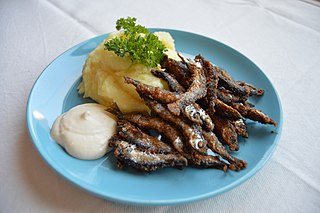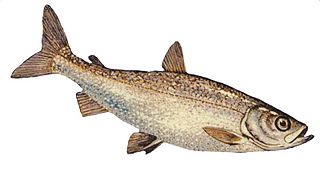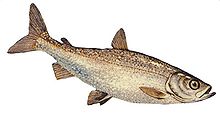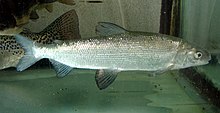
Coregonus lavaretus is a species of freshwater whitefish, in the family Salmonidae. It is the type species of its genus Coregonus.

Stenodus leucichthys is a species of freshwater whitefish in the family Salmonidae. In the strict sense its natural distribution is restricted to the Caspian Sea basin. It is now considered extinct in the wild, but survives in cultured stocks. The nelma, a more widespread species of Eurasian and North America, is sometimes considered its subspecies.

The ciscoes are salmonid fish that differ from other members of the genus Coregonus in having upper and lower jaws of approximately equal length and high gill raker counts. These species have been the focus of much study recently, as researchers have sought to determine the relationships among species that appear to have evolved very recently. The term cisco is also specifically used of the North American species Coregonus artedi, also known as lake herring.

The gwyniad is a freshwater whitefish native to Bala Lake in northern Wales.

The blackfin cisco was a North American salmonid fish in the freshwater whitefish sub-family Coregoninae. This silvery, deep-bodied fish with black fins, large eyes, a blunt snout and a terminal mouth, was one of the largest forms of ciscoes. The blackfin cisco used to inhabit the Great Lakes of North America until recently, but has been reported to have gone extinct. The blackfin cisco is a member of the C. artedi complex, whose taxonomy has not yet been resolved, and it may not represent a valid species.

Coregonus albula, known as the vendace or as the European cisco, is a species of freshwater whitefish in the family Salmonidae. It is found in lakes in northern Europe, especially Finland, Latvia, Lithuania, Sweden, Russia and Estonia, and in some lakes of Norway, the United Kingdom, northern Germany, and Poland. It is also found in diluted brackish water in the Gulfs of Finland and Bothnia, both of which are in the Baltic Sea.

Coregonus sardinella, known as the least cisco or the sardine cisco, is a fresh- and brackishwater salmonid fish that inhabits rivers, estuaries and coastal waters of the marginal seas of the Arctic Basin, as well as some large lakes of those areas.
The schelly is a living fresh water fish of the salmon family, endemic to four lakes in the Lake District, England. Its taxonomy is disputed with some recognizing it as a distinct species and others as a variant of the widespread Eurasian whitefish species Coregonus lavaretus. It is present in Brothers Water, Haweswater, Red Tarn and Ullswater, and the population seems stable in all of these except for Haweswater where it seems to be declining. The main threats it faces are seen to be water abstraction and cormorants, and the fish-eating birds are being culled from Haweswater. The International Union for Conservation of Nature has rated the conservation status of this fish as "endangered".

The Atlantic whitefish is a coregonine fish inhabiting some freshwater lakes within Nova Scotia, Canada. It is known to survive only in the Petite Rivière watershed as landlocked populations. Earlier it was also found in the Tusket and Annis rivers of Nova Scotia. Those populations were anadromous, migrating to the estuary to feed while breeding in freshwater.
Stenodus is a genus of large-sized whitefish in the family Salmonidae. It consists of two species; one of them (beloribitsa) is extinct in wild. The two species have alternatively been considered subspecies of the single species Stenodus leucichthys.

The freshwater whitefish are fishes of the subfamily Coregoninae, which contains whitefishes and ciscoes, and is one of three subfamilies in the salmon family Salmonidae. Apart from the subfamily Coregoninae, the family Salmonidae includes the salmon, trout, and char species of the subfamily Salmoninae, and grayling species of the subfamily Thymallinae. Freshwater whitefish are distributed mainly in relatively cool waters throughout the northern parts of the Northern Hemisphere.

Coregonus artedi, commonly known as the cisco, is a North American species of freshwater whitefish in the family Salmonidae. The number of species and definition of species limits in North American ciscoes is a matter of debate. Accordingly, Coregonus artedi may refer either in a narrow sense to one of the several types of cisco found e.g. in the Great Lakes, or in a broad sense to the complex of all ciscoes in continental North American lakes, Coregonus artedi sensu lato.
Coregonus fontanae, also known as the Stechlin cisco, Fontane cisco, or Fontane's cisco, is a putative species of freshwater whitefish in the family Salmonidae endemic to the Großer Stechlinsee in northern Germany. It is believed to have recently evolved from the sympatric vendace, Coregonus albula.

Coregonus maraena, referred to in English as the maraene, maraena whitefish, vendace, cisco, lake herring, lake whitefish or the whitefish, is a whitefish of the family Salmonidae that occurs in the Baltic Sea basin - in the sea itself and the inflowing rivers, and in several lakes as landlocked populations. It is found in Denmark, Estonia, Finland, Germany, Latvia, Lithuania, Netherlands, Norway, Poland, Slovakia, Russia and Sweden. As of 2013, it has been listed as a vulnerable species by the IUCN and as endangered by HELCOM. It is an extremely important fish within the Baltic Sea ecosystem, both for population equilibrium and for the local diets of the surrounding human population. Due to a variety of factors, mostly overfishing, the maraena's population dwindled to near-extinction levels. Thus, rampant repopulation was enacted to preserve this important fish.

The Peipsi whitefish is a freshwater whitefish of the family Salmonidae that naturally occurs in Lake Peipus on the border of Estonia and Russia, from where it also ascends to Lake Võrtsjärv to spawn. It has been introduced in Lake Burtnieks (Latvia), Gulf of Riga, many lakes of northern Russia, Poland, Germany, Netherlands, Japan, Lake Sevan (Armenia) and Balkash (Kazakhstan). It is a benthopelagic fish up to 60 cm long.

The Ives Lake cisco is a freshwater whitefish known to inhabit a single inland lake in the Upper Peninsula of Michigan. The species was last observed in 1983, although there is disagreement on whether it is distinct from Coregonus artedi. This taxon has been found only in Ives Lake, a lake in the Huron Mountains. The lake encompasses a radius of less than 1.5 miles (2.4 km).

Coregonus widegreni, also called the Valaam whitefish, is a putative species of freshwater whitefish, a part of the common whitefish complex from Northern Europe. It is a demersal form of freshwater whitefish that feeds on benthic invertebrates. It spawns in late autumn, and can reach a length of 55 cm maximum. It is characterized by a low gill raker density.
Coregonus nilssoni is a putative species of whitefish, part of the Coregonus lavaretus complex. It is a pelagic fish feeding on zooplankton. Its distribution is in lakes of Sweden, southern Norway, Denmark and Poland.
Coregonus pallasii is a putative species of whitefish in the family Salmonidae, part of the Coregonus lavaretus complex.
Coregonus candidus, locally known as shiny whitefish, is a freshwater species of fish of the genus coregonus, which is also known as whitefish, found in the Lake Neuchâtel and Bienne of Switzerland. The fish is classified as vulnerable according to the IUCN standard due to overfishing and improper management of the water body.


















